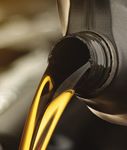TRENDING TOPICS ASIA PACIFIC
←
→
Page content transcription
If your browser does not render page correctly, please read the page content below
CASUALTY // EXPLORATION & PRODUCTION
Oil and gas extraction
in Australia
JANUARY 2017
TRENDING The Australian oil and gas extraction industry
is growing, and projections indicate that both
TOPICS production and export are likely to continue
increasing. The industry by nature involves large,
ASIA PACIFIC capital-intensive and complex plants and potentially
volatile, often toxic products.Export performance is directly
correlated with industry
performance
First things first: let’s get some of the when released as a gas from high-pressure These are the ‘big guns’, often household-
industry jargon out of the way. LNG wells, becomes liquid. word players, such as Woodside Petroleum,
(Liquefied Natural Gas) is formed when BHP Billiton, Chevron Australia Holdings,
The oil and gas extraction industry
natural gas is cooled to a very low ExxonMobil Australia, Santos and Shell
mainly produces crude oil, natural gas or
temperature, whereas LPG (Liquefied Energy Holdings Australia, not ‘mom-and-
condensate from oil and gas deposits.
Petroleum Gas) is naturally occurring pop’ enterprises. And yet, the industry’s
Companies in the industry may purify
gas – such as propane – which is kept health and performance affects, at least
natural gas, liquefy hydrocarbon gas or
under pressure to keep it in liquid form. A indirectly, every household and business in
operate natural gas absorption or separation
condensate is a type of light crude oil that, Australia.
operations. Some produce LNG and LPG.i
Key factors
The vagaries of world oil and gas prices, the An estimated three-quarters of the $38 The global crude oil price is intimately
Australian dollar/US dollar exchange rate, billion in 2016-2017 revenues can be linked to the industry performance, even
the 10-year bond rate, domestic and export attributed to exports: LNG export dominates for gas extraction, as it is customary for
demand for the product, and production (57.8%), followed by crude oil (17.2%) and contracts for gas supply to be quoted on
volumes are the main influences on the LPG (1.7%).i This speaks volumes about the benchmark oil prices.
industry’s performance.i Their impact is industry’s vulnerability to foreign demand for
Natural gas accounts for over $21 billion (or
complex, which results in volatile revenues the commodity, trends in oil and gas output,
56.1%) of the total industry revenue, with
for the industry. Although the domestic the US-dollar price they can command and
crude oil and condensate (11 billion; 29.5%)
industry output, measured in barrels of oil fluctuations in the value of the Australian
leading the rest of the pack (see Figure 1).i
equivalent (BOE), has increased in the last dollar. Put simply, export performance is
five years and the global demand for LNG in directly correlated with industry performance.
particular has increased significantly in the
The strength of the Australian dollar against
same period, global oil and gas prices have
the US dollar has a direct effect on domestic
both declined (this, despite the fact that until
industry revenue. For example, the relatively
2014, LNG prices remained buoyant as long
weak Australian dollar limited local price
as increased demand challenged supply
drops (and protected local revenue) when
volumes and a weaker Australian dollar
there was a global slump in oil prices during
supported export).i
2015-2016.Products and services segmentation
(2016-17) Output (%)
Total $38.0bn
NT
0.9
QLD
11.0
WA
64.1
SA
6.8
NSW
6.3 ACT
0.0
VIC
Cold zone (Going global: oil and gas extraction
2005-2016
200 Export Global
Exports/Revenue
150
100
2016
50 2005
Local Import
0
0 40 80 120 160
Imports/Domestic demand
Figure 3. Globalisation in the oil and gas extraction
industry (IBISWorld Industry Report B0700
Oil and Gas Extraction in Australia –
September 2016)
There are six main players in the industry, Internal competition between oil and gas
namely (in order of market share) Woodside extraction companies is high and steady,
Petroleum (14.2%), BHP Billiton (12.1%), however, and is largely based on price,
Chevron Australia Holdings (11.6%), rather than product differentiators.
ExxonMobil Australia (11.3%), Santos
The industry features high and increasing
(11.0%) and Shell Energy Holdings
globalisation (see Figure 3). Foreign
Australia (10.8%). There is medium market
ownership (Shell, Exxon, Chevron)
share concentration, with the four largest
dominates local (Woodside) or part-
companies accounting for 49.2% (and the
local ownership (BHP Billiton) and the
top seven, approximately 75%) of 2016-2017
international trade of both exports and
industry revenue.i Industry concentration has
imports is a feature. Oil and gas exports
increased in recent years as major players
are estimated to contribute more than 75%
have continued to increase their market
of industry revenue for 2016-2017 and this
share and benefit from economies of scale,
figure is expected to increase over the next
while high barriers to entry (such as the
five years as Asian LPG demands soar.i
high-risk nature of oil and gas extraction and
the onerous capital investment) have limited
external competition from new contenders.Industry performance
Revenues are predicted to increase at a costs can be high; and the tax burden of
modest 1.4% for the five years to 2017 to producers has increased since 2012. All of
reach $38.0 billion, with industry outputs these factors conspire to drive profits down.
barely offsetting the 2014-2016 falls in
Export growth in the industry is expected
oil and gas prices.i Declining crude oil
to soar in the short term in response to a
production from Australia’s mature oil
surge in both global demand and domestic
resources have negatively affected revenue
production: Australian output is pegged
growth, despite healthy LNG volumes over
at 567 million BOE in 2016-2017, which
the last five years.i In fact, gas extraction
represents an increase of 14.3% for the
has been the fastest growth nexus for the
year.i This, combined with anticipated
industry during this period, with increasing
higher prices, means that industry revenues
global demand driving prices up in a
are expected to jump 16.8% for the same
marketplace where few countries compete
period.i Interestingly, despite industry
for international LNG trade.
consolidation reducing the number of
The long lead-time to production (typically enterprises, employment in the industry
10 years) of asset investment means that has risen markedly over the last five years
large projects currently under construction in tandem with the growth in revenues and
are due to come online in the next five output.i
years, further boosting production levels
So-called unconventional resources (CSG,
that have been increasing over the last five
shale gas and shale oil) are subject to
years. Furthermore, with established export
controversy and regulations vary between
terminals in WA, Australia is in a strong
states; however, Australia is rich in these
position to benefit from the burgeoning LNG
resources and output is growing from
demand from Japan, which has converted
approved outlets. For example, LNG from
to gas-fired energy supply in the wake of the
Queensland CSG has been exported in
2011 Fukushima disaster.i
increasing volumes since 2014-2015.i
Investments are typically long term in the oil
and gas extraction industry; fixed productionThe Australian oil and gas
extraction industry is growing
Operating conditions Powering ahead…
Capital intensity is high in the industry, with Under a gas reservation policy, WA The Australian oil and gas extraction
large amounts of capital being required to producers are compelled to reserve 15% of industry is growing, and projections indicate
develop new – or upscale existing – fields. gas for domestic consumption. Since July that both production and export are likely to
Wage costs, even considering a highly 2012, an onerous Petroleum Resource Rent increase over the next five years to 2022.
skilled and well-paid workforce, are relatively Tax (PRRT) of 40% has been levied on all By 2021-22, revenue is predicted to reach
insignificant against capital costs. onshore and offshore oil and gas production, more than $61 billion – even in the face of
including CSG operations that are not stabilising oil and gas prices – 85.7% of
All stages of production are heavily
incidental to coal mining- which will be contributed by a still-expanding
regulated. The Commonwealth controls
export market. Production in 2021-22 is
mining beyond a three-mile nautical limit; The industry receives no tariff – or direct
estimated to be 821 million BOE.
the states control both the landward side of non-tariff – protection, nor does it receive
that limit and all onshore oil production. Both any government subsidies or grants.
onshore and offshore operations are subject
to a three-tier system: that is, an exploration
permit, a retention lease preserving tenure
on as-yet non-commercial discoveries, and a
production licence.…yet always subject to operational risks
The oil and gas extraction industry, by its Insurance may not prevent either disaster
very nature, involves large, capital-intensive or business interruption, but it can provide
and complex plant and potentially volatile, peace of mind and may soften the financial
often toxic products. The outbreak of fire blow if things go awry. A reputable insurance
on an oil or gas field is always a potential company should offer specialised risk
risk; pipe failure or an oil spill could have engineering analysis of the site-specific
a devastating environmental impact; and operational risks, and should be able to offer
equipment breakdown or failure could practical advice on mitigating such risks.
cause significant disruption or pose a risk Appropriate insurance cover might include
of personal injury. Needless to say, scale of General Liability, Environmental Impairment
operation is no protection: even the largest Liability, Professional Indemnity, Directors’
operations are vulnerable. and Officers’ Liability, Industrial Special
Risks and even Cyber insurance.
Any one of these scenarios may cause
business interruption, with potentially
major loss of revenue – especially when oil i IBISWorld Industry Report B0700 Oil and Gas Extraction in
Australia – September 2016.
prices are high – and perhaps damage to
ii St John, A, The coal seam gas debate, Parliament of Australia
the company’s reputation. Media and local http://www.aph.gov.au/About_Parliament/Parliamentary_
community interest is readily piqued by Departments/Parliamentary_Library/pubs/BriefingBook44p/
GasDebate
visually dramatic oil spills, fires or explosion,
and a company’s ability to rapidly contain
or limit the damage may prove vital for its
ongoing image management.A relationship that protects what you value most
Distinct, complex and constantly evolving As a global insurer and reinsurer backed by
– every business is as unique as their Liberty Mutual, this is what we promise.
insurance needs.
We partner with insurance brokers to
To confidently progress in the face of risk bring value and solutions to the world’s
and uncertainty requires a level of security most significant business and government
you can only achieve through working organisations – helping them protect what
with specialists. they earn, build and own.
Contact us
If you’re looking for more information on insuring exploration and production projects,
please get in touch with our specialist Oil & Gas underwriters. Our full team is listed on
our websites.
Matthew Johns
Assistant Vice President
Casualty & SA Branch Manager
Asia Pacific
T +61 8 8124 8508
E matthew.johns@libertyglobalgroup.com
libertyspecialtymarketsap.com
All information in this guide is general in scope and, to the best of our knowledge, current at the time of publication. No attempt has
been made to interpret any referenced codes, standards or regulations. You should not rely on this information without first obtaining
professional advice. © Liberty 2017. Please contact Liberty for a licence to use and distribute this document. This information is
current as at January 2017. Liberty means Liberty Specialty Markets, a trading name of Liberty Mutual Insurance Company, Australia
Branch (ABN 61 086 083 605) incorporated in Massachusetts, USA (the liability of members is limited); Liberty Specialty Markets
Hong Kong Limited (No. 2400200); and Liberty Specialty Markets Singapore Pte Limited (UEN 201538069C) with a branch in
Labuan (Company No. LF12903).
AP0411-01-17You can also read



























































